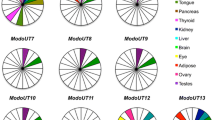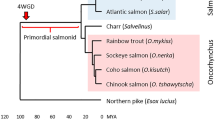Abstract
The amphibian Xenopus laevis is one non-mammalian vertebrate in which the major histocompatibility complex (MHC) has been analyzed extensively. Class IIβ, class Ia, LMP2, LMP7, HSP70, C4, Factor B, and Ring3 genes have been identified and mapped to the MHC. Here, we report the isolation of a transporter associated with antigen processing (TAP) gene, TAP2, and demonstrate its linkage to the MHC. While the ATP-binding region of Xenopus TAP2 is highly conserved in evolution, amino acid identity to other vertebrate TAP proteins was not detected in the N-terminal region. Segregation analysis of 34 individuals from two families showed exact restriction fragment length polymorphism matching between the MHC class Ia gene and the one TAP2 gene demonstrating linkage conservation since the mammalian/amphibian divergence ∼350 million years ago. In addition, one non-MHC-linked TAP2–hybridizing fragment was detected in approximately half of the individuals tested. Interestingly, TAP2 allelic lineages appear to match those of LMP7 and classical class I, which previously were categorized into two highly divergent groups that emerged at least 60 million years ago. Similar to LMP7 and class Ia,TAP2 is expressed ubiquitously with highest levels in intestine and spleen.
Similar content being viewed by others
Author information
Authors and Affiliations
Additional information
Received: 2 March 1998 / Revised: 15 July 1998
Rights and permissions
About this article
Cite this article
Ohta, Y., Powis, S., Coadwell, W. et al. Identification and genetic mapping of Xenopus TAP2 genes. Immunogenetics 49, 171–182 (1999). https://doi.org/10.1007/s002510050478
Issue Date:
DOI: https://doi.org/10.1007/s002510050478




